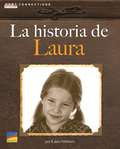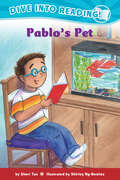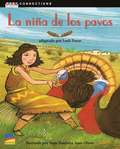- Table View
- List View
La historia de William Hoy: Cómo un jugador sordo cambió el deporte del béisbol (¡Arriba la Lectura!, Read Aloud Module 1 #3)
by Nancy Churnin Jez TuyaNIMAC-sourced textbook
La historia de la nieve: La ciencia de la maravilla del invierno (¡Arriba la Lectura!, Read Aloud Module 6 #2)
by Mark Cassino Jon Nelson Nora AoyagiNIMAC-sourced textbook
La historia del agua: Una aventura en movimiento (¡Arriba la Lectura!, Level R #57)
by Diane BairNIMAC-sourced textbook. ¡Hay mucho que aprender sobre el agua! Este libro te cuenta todo sobre el agua; por ejemplo, lo importante que es para la vida. Aprenderás sobre la contaminación del agua y cómo todos podemos ahorrar ese valioso recurso.
La hora de los primos: Factores y múltiplos
by Glenda Lappan James T. Fey Susan N. Friel Elizabeth Difanis PhillipsNIMAC-sourced textbook
La hormiga y la paloma (¡Arriba la Lectura!, Level I #5)
by Rob Arego Martin MelognoNIMAC-sourced textbook. Una hormiga y una paloma aprenden una valiosa lección: los amigos se cuidan unos a otros.
La hormiguita y el pájaro blanco (¡Arriba la Lectura! Level F #40)
by Debbie Croft Dale NewmanNIMAC-sourced textbook <p><p> Una hormiguita se acerca demasiado a un río y cae al agua. ¿Quién la salvará del río caudaloso?
La isla de la doctora Chu desaparece (¡Arriba la Lectura!, Level V #70)
by Marianne Posadas Mat TaitLa millonaria Dra. Chu ha creado un paraíso artificial, pero los problemas están a punto de empezar. Cuando la isla empieza a derrumbarse bajo los efectos de un ciclón tropical, ella intenta desesperadamente averiguar qué se le olvidó: ¡algo que todo paraíso necesita! NIMAC-sourced textbook
La jungla del acuario (¡Arriba la Lectura!, Level O #5)
by Cameron Macintosh Ned CulicNIMAC-sourced textbook
La laguna (¡Arriba la Lectura!, Leveled Reader Benchmark K-2, Level H #8)
by Rob Arego Toby WilliamsNIMAC-sourced textbook
La lección del guerrero valiente: Un cuento indígena americano (¡Arriba la Lectura!, Level O #4)
by Sally Cowan Joseph QiuNIMAC-sourced textbook. Un guerrero regresa a su aldea después de muchos años. Les cuenta a los aldeanos historias sobre lo valiente que es y por qué todos deberían obedecerlo por eso. Pero hay alguien en la aldea que le va a enseñar una lección a este guerrero valiente.
La leyenda del altramuz azul (¡Arriba la Lectura!, Level N #36)
by Diana Kizlauskas Pat RiptonEl pueblo comanche está sufriendo. No cae lluvia del cielo. ¿Qué podrá hacer el pueblo comanche para convencer a la Madre Tierra de que los ayude? NIMAC-sourced textbook
La maleta perdida (¡Arriba la Lectura!, Level I #13)
by Elsie Nelley Nathalie OrtegaNIMAC-sourced textbook. ¡Estoy muy feliz! Sofu y Sobo, mis abuelos, vienen de muy lejos, de Japón, a visitarnos. Pero cuando fuimos a buscarlos al aeropuerto, Sobo parecía enojada. ¡Algo pasaba!
La mascota de Pablo: (Pablo's Pet, Dive Into Reading) (Confetti Kids #9)
by Sheri TanEn este nuevo libro de la serie popular Confetti Kids, Pablo aprende a hacer frente a la pérdida de su querida mascota con la ayuda de sus amigos y familiares.Cuando Pablo descubre que su pececita, Ruby, ha muerto, debe aprender a hacer frente a la pérdida. Por suerte, los amigos y la familia de Pablo están junto a él para ayudarlo a recordar los buenos tiempos que pasó con Ruby.
La meta de Benito (¡Arriba la Lectura!, Level Q #38)
by Dan Brown Margarita González-Jensen Anne KaskeNIMAC-sourced textbook. Por donde sea que vayan, Benito y sus amigos siempre van en equipo. Cuando Benito decide cambiarse de equipo de fútbol, pone a prueba su amistad. ¿Se dará cuenta de quiénes son sus amigos de verdad antes de que sea demasiado tarde?
La miel (¡Arriba la Lectura! Level K #83)
by Julie HaydonNIMAC-sourced textbook <p><p> ¿Sabes cómo hacen la miel las abejas? ¿Sabes qué tarea cumple cada tipo de abeja? ¡Lee y lo sabrás!
La misteriosa cápsula del tiempo (¡Arriba la Lectura!, Level O #6)
by Annette Smith Rebecca SolowNIMAC-sourced textbook. En la escuela de Meadow Valley, encontraron una misteriosa caja metálica debajo de un árbol. Dentro de ella, había tres notas escritas por unos niños hace 75 años. ¿Quiénes fueron esos niños y dónde están ahora?.
La misteriosa señorita Martín (¡Arriba la Lectura!, Level N #35)
by Ilene Richard Jeanie StewartA Hao y a su prima Lan les encantan los relatos de misterio. ¡Pero a Lan le gustan mucho más los misterios de la vida real! Lan está convencida de que su vecina, la señorita Martín, está metida en un asunto muy sospechoso. ¿Podrán Hao y Lan resolver este misterio de la vida real? NIMAC-sourced textbook
La máscara misteriosa (¡Arriba la Lectura!, Level N #81)
by David Calcutt Robert EberzNIMAC-sourced textbook. Annie y Will encuentran una máscara muy vieja en el desierto. ¿Quién la hizo y por qué estaba escondida? ¿Lograrán resolver el misterio?
La música y el baile flamenco (¡Arriba la Lectura!, Level N #76)
by Heather HammondsNIMAC-sourced textbook. El flamenco es un tipo de música y baile de España. La gente canta, baila y toca la guitarra. Hay grandes espectáculos de flamenco en todo el mundo. ¡El flamenco es muy entretenido para todos!
La niña del gorro rojo de lana al rescate (¡Arriba la Lectura!, Read Aloud Module 9 #4)
by Naoko StoopNIMAC-sourced textbook



